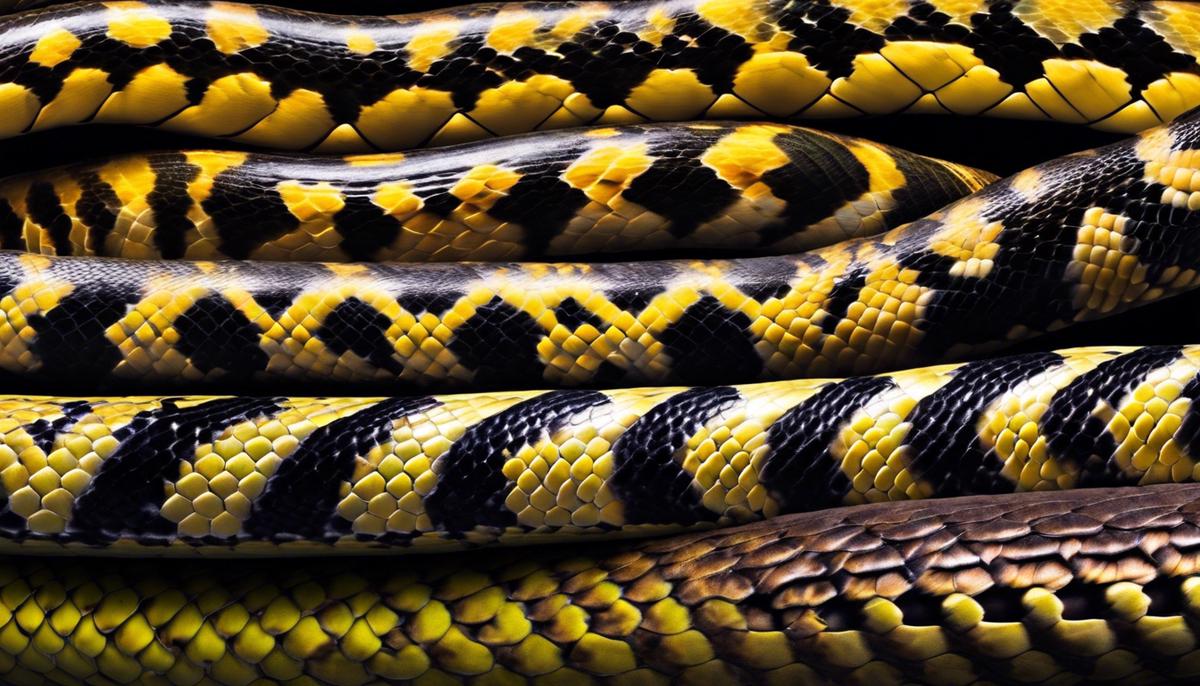Dreams have long been a subject of fascination, containing symbols and echoes from our subconscious mind, leading to a realm ripe for interpretation and analysis. One such intriguing symbol is the anaconda. This powerful creature, renowned for its strength and deadly attributes, harbors profound significance in one’s dream realm. This exploration ventures deep into the world of dream interpretation, specifically the imagery of the anaconda, dissecting its symbolic roles, psychological impacts, and cultural undertones. Through a mix of cultural interpretation, psychological examination, and detailed case studies, we seek to illuminate the mysteries of the anaconda motif and the profound implications it holds for individuals who encounter them in their dreams.
Symbolic Interpretations of the Anaconda Image
Unfurling the Unconscious: An Exploration of Anacondas in Dream Symbolism
As we slumber, the subconscious mind unearths a treasure trove of symbolism that frequently baffle the waking mind. One figure of particular intrigue and mystery is the anaconda, a formidable and powerful creature from the South American wilderness. This colossal creature has held a captivating place in human imagination and, as such, often features in our dreamscapes.
A psychological interpretation of dreaming of an anaconda leans towards the theories of Carl Gustav Jung. Jung emphasized the role of personal and archetypal experiences in dream symbolism. Therefore, the anaconda, bathed in mystery and primeval dread, is seen as an embodiment of the shadow – a Jungian term representing the unconscious parts of our personality which the conscious mind refuses to acknowledge. Dependent on one’s personal experience with anacondas, it may symbolize buried emotions or hidden fears that are surfacing into the conscious realm through dreams.
The anaconda could also be viewed as a manifestation of the Freudian concept of “id“, the part of our subconscious where our most primal instincts lie. As this powerful serpent lurks in the murkiness of the river, so does our “id” in the recesses of the human mind. It is possible that the appearance of an anaconda in one’s dream might indicate a hidden desire or instinct grappling to make itself seen.
By shifting our attention towards cultural symbolism, the anaconda can also be seen embodying wisdom, secrecy, and spiritual potency. Many indigenous cultures of South America revere the anaconda as a representation of the vital life force and the circle of life and death. Its association with the elemental force of water further amplifies its symbolism, linking it to both creation and destruction. Therefore, dreaming of anacondas may be symbolic of a personal evolution or transformation, signifying the need for profound understanding or indicating a transitional phase in one’s life.
Exploring dream symbolism is akin to deciphering an intricate code unique to an individual – a blend of personal, cultural, and universal meanings. The anaconda is one such fascinating cipher, a sibylline creature swathed in layers of psychological and symbolic interpretations. Tracing the winding pathways of the unconscious, it ushers in a deeper understanding of the self and offers new insights, despite its menacing portrayal. It reminds us that fear can often mask wisdom and that, sometimes, we need to dive deep into our murky pools of the subconscious to unravel the treasures hidden within.

The Implications of Dream Analysis
In the panorama of psychological research, delving into dream motifs, such as the anaconda, offers substantial insights. Our nocturnal cognitions are often a rich sluice of cues to our deeper, subconscious landscapes, which traditional methods of psychological analysis may fail to access. Consequently, unraveling the symbolism and meanings often hidden in our dreams becomes a necessary path to knowledge and understanding.
Post-Jungian psychologists have widely embraced the idea that dream motifs, such as the anaconda, offer a valuable insight into innate human archetypes. These archetypes, whether they pertain to the shadow, the anima, or any other universal symbol, represent collectively inherited unconscious ideas, patterns of thought, images, etc. Therefore, the analysis of anacondas in dreams allows for the uncovering of these archetypes that are characteristic to a specific individual, thus revealing universally shared, yet personal experiences and concepts.
Similarly, post-Freudian schools of thought accord significance to dream motifs, believing that these images are direct expressions of our drives and instincts – our Freudian “id”. Thus, anacondas in dreams could allude to the deepest, primal aspects of people’s psyche, laying bare the raw force of the id. Comprehending this, psychology is better equipped to decipher and address unconscious impulses and their repercussion on an individual’s thinking, emotions, behavior, and overall mental well-being.
Terrains of cultural symbolism prove to be substantial sites to mine for psychological insights as well. Indigenous communities, for example, are known to hold the anaconda in high esteem, denoting wisdom, spiritual potency, and transformation. Tapping into these collective imaginations and traditional wisdom, researchers can glean sophisticated interpretations of cultural symbols, thereby understanding a culture’s collective psychology. Also, cross-cultural comparisons of these symbols could help unearth fundamental human experiences and fears.
Furthermore, the analysis of dream motifs serves as a tool for personal growth and transformation. As anacondas are seen as symbols of evolution or transformation—shedding old skin for the new—interpreting them in dreams could hint at personal transitions or milestones an individual might be going through or approaching. This interpretation aids in the offering of suitable therapeutic interventions aimed at personal growth and better mental health.
Lastly, understanding dream symbolism acts like deciphering a unique code. Just like an archaeologist brushes the dust away from a millennia-old artifact to decipher its hidden meanings, psychologists similarly scrutinize dream motifs to uncover the substratum of our unconscious minds—the fears, ambitions, desires, and instincts that mold us as individuals. With this comprehension springs novel insights into human behavior and mind, marking a leap forward in psychological research and therapy.
In sum, the relevance of dream motifs like the anaconda in psychological research cannot be overstated. These motifs serve as mirrors reflective of our subconscious, guiding to hidden neural pathways, and shedding light on the mysteries of our psyches. Pursuing this stream of inquiry, no doubt, deepens our understanding of human cognition and behavior, ultimately contributing a vibrant spectrum to the palette of psychological knowledge.

Case Studies Investigating Anaconda Dreams
Drawing from the rich and varied landscape of dream interpretations, we find ourselves compelled to delve deeper into specific case studies. It is in these case studies that we see the concreteness of the abstract, the elucidation of mysterious dream symbolism such as that of the anaconda.
Consider the case of a prominent corporate lawyer. With a successful career and a prolific reputation, she approached a psychologist due to recurrent dreams of a monstrous anaconda, inducing a sense of fear and curiosity. Upon analyzing the dream symbolism in her waking life context, the anaconda was interpreted to represent her confrontations with a predominantly male corporate culture – the anaconda acting as an embodiment of intimidation, aggression and power struggle.
In another instance, a university student who was generally introverted and guarded, frequently experienced dreams of an anaconda in a non-threatening demeanor. For him, the anaconda was symbolic of his repressed feelings and inherent capabilities that he had been reluctant to express to the outside world.
Since dream interpretation is a highly subjective process, the intricate details of the dream narratives play a critical role. The same symbol can take on different meanings depending on the dreamer’s personal circumstances and emotional state. For instance, in a different case, an anaconda appeared to an individual during a phase of spiritual seeking. The anaconda was interpreted to embody spiritual wisdom and inner transformation – portending the dreamer’s journey into a deeper spiritual quest, aligning well with the concept of anacondas representing wisdom and spiritual potency.
Moreover, the recurring dream of an anaconda indicates its importance and influence on the individual dreamer’s psyche. This recurrence can often be linked to unresolved issues and emotions, where the dreamer is frequently provoked to face an unaddressed aspect of their life, manifested as an anaconda in their dreams.
In consideration of indigenous cultures of South America, the anaconda often has a revered place in their folklore and spiritual practices. An individual from such a background may experience a dream featuring an anaconda alongside associated cultural symbols, offering valuable insights into their cultural identity and inherited wisdom.
In conclusion, dreams featuring anacondas can encapsulate a gamut of meanings and associations depending on various factors such as personal circumstances, psychological dispositions, cultural backgrounds, and emotional states. Therefore, these case studies are not uniform interpretations but unique narratives giving insights into the multi-dimensional nature of human experiences, subconscious mind, and the primal instincts and drives these symbols are connected to. Beyond the individual level, these cases also elucidate the broader implications for understanding human experiences, enhancing psychological research, and providing new tools for therapy.

Impact of Culture and Personal Beliefs
The intricate nature of dream interpretation within the context of personal and cultural beliefs is a field that has seen an amalgamation of both traditional wisdom and modern psychological insights. Carrying forward from the previously covered aspects of anaconda symbolism and its interpretations in dreams, in this part of the discourse, consider the layer of influence that societal, cultural, and personal beliefs impress upon these interpretations.
Anacondas, widely associated with power and primal energy in various societies, may witness altered interpretations based on one’s cultural backdrop. Take for instance, an individual from indigenous Amazon communities, for whom an anaconda is not just an animal, but an integral part of cultural wisdom and folklore. In this context, if this individual envisions an anaconda in the dream state, the interpretation may have roots in historical and cultural storytelling, possibly even imbuing the dream with ancestral messages or spiritual portents.
Meanwhile, for a city dweller with a Western background and no strong cultural affiliation with the anaconda, the dream may nevertheless grab attention and warrant interpretation due to its unusual content. However, interpretation in this case will likely be guided by personal beliefs or fears and not necessarily common cultural tropes. For instance, psychoanalytical theories might suggest that the anaconda represents suppressed anxiety or fear and that the individual might be dealing with pressing issues related to power, control or intimidation.
Stepping beyond the purely psychological lens, personal beliefs and values also significantly shape the understanding and reaction to such dreams. An individual with a fascination for the wilderness might interpret an anaconda in dreams as an invitation to explore wild, unchartered aspects of life or self – an adventurous call from the subconscious. In contrast, someone with a phobia of reptiles might interpret the same dream as a representation of an impending threat or challenge.
This highlights a critical realization within dream interpretation studies- the centrality of the interpreter in ascribing meaning to dream content. More than just being passive recipients of arcane subconscious symbols, dreamers actively assign meaning to their dreams based on their unique sociocultural and personal contexts. Further, therapists dealing with dream interpretation must be cognizant of these dynamics while guiding clients through their dream narratives. This approach ties into Carl Jung’s idea of individuation, asserting that the path of self-discovery is an intensely personal journey.
Thus, the interpretation of anaconda dreams is not merely an act of translation based on a universal dream dictionary, but rather a dynamic process that is influenced by the dreamer’s cultural background, personal beliefs, and value systems. Conclusively, the symbology of anaconda dreams unfolds at the interstices of the personal and collective mind, always open to a myriad of interpretations shaped by a broad spectrum of human influence.

As we have journeyed through the depths of the dream world and navigated the complex, serpentine symbol of the anaconda, it becomes clear that our dreams are a mirror into our subconscious, reflecting our thoughts, fears, aspirations, and experiences. The presence of an anaconda in dreams, far from being just a random occurrence, carries diverse and significant meanings shaped by individual and cultural contexts. Be it a symbol of power, danger, subconscious fears or transformation, the appearance of the anaconda is a potent message inviting us to introspect, analyze and draw insights to enhance our understanding of ourselves. Imbued with a wealth of meanings, giving enlightening insights into the human psyche, the anaconda continues to be a captivating symbol in the ever-enigmatic world of dreams.







